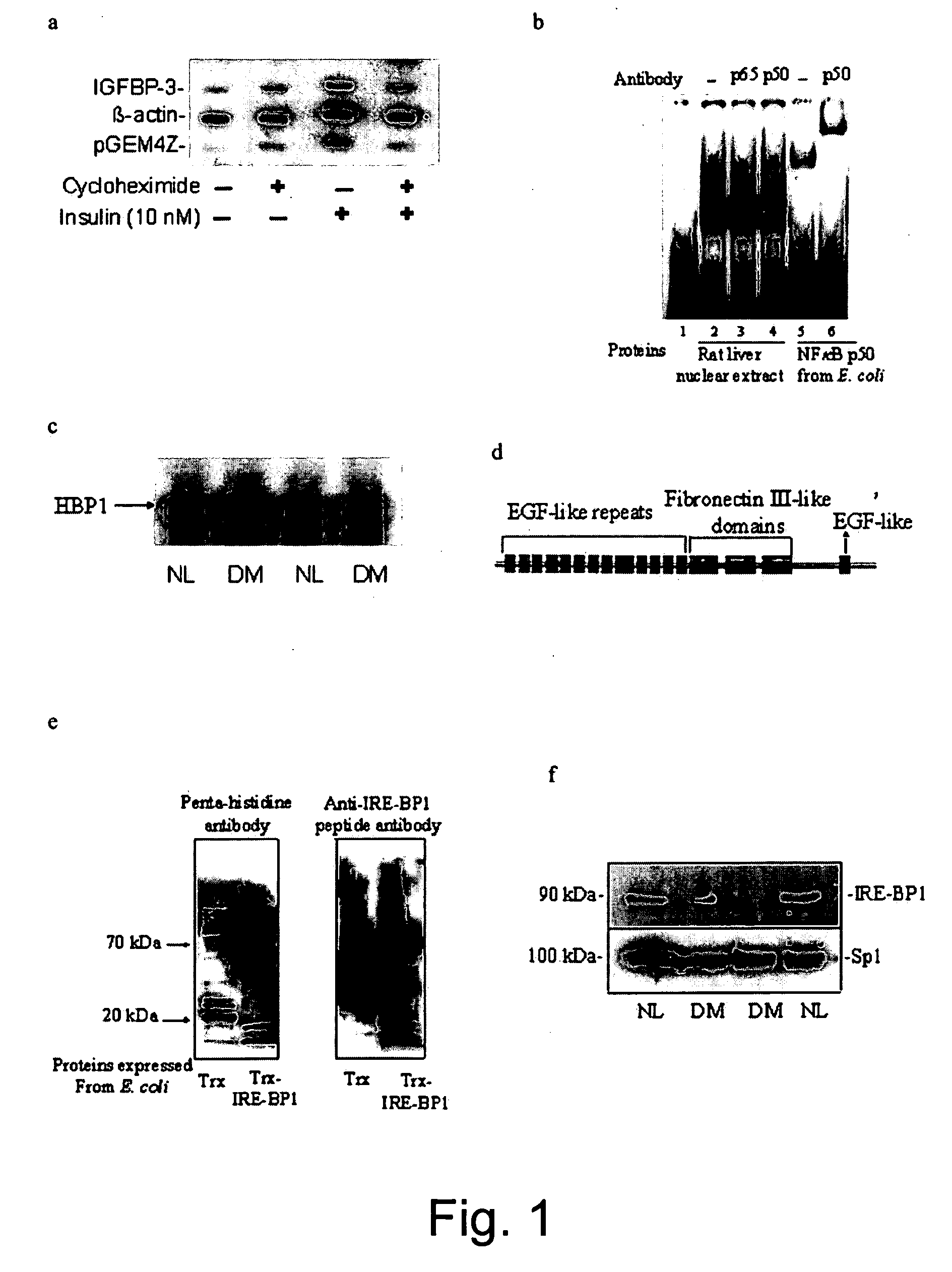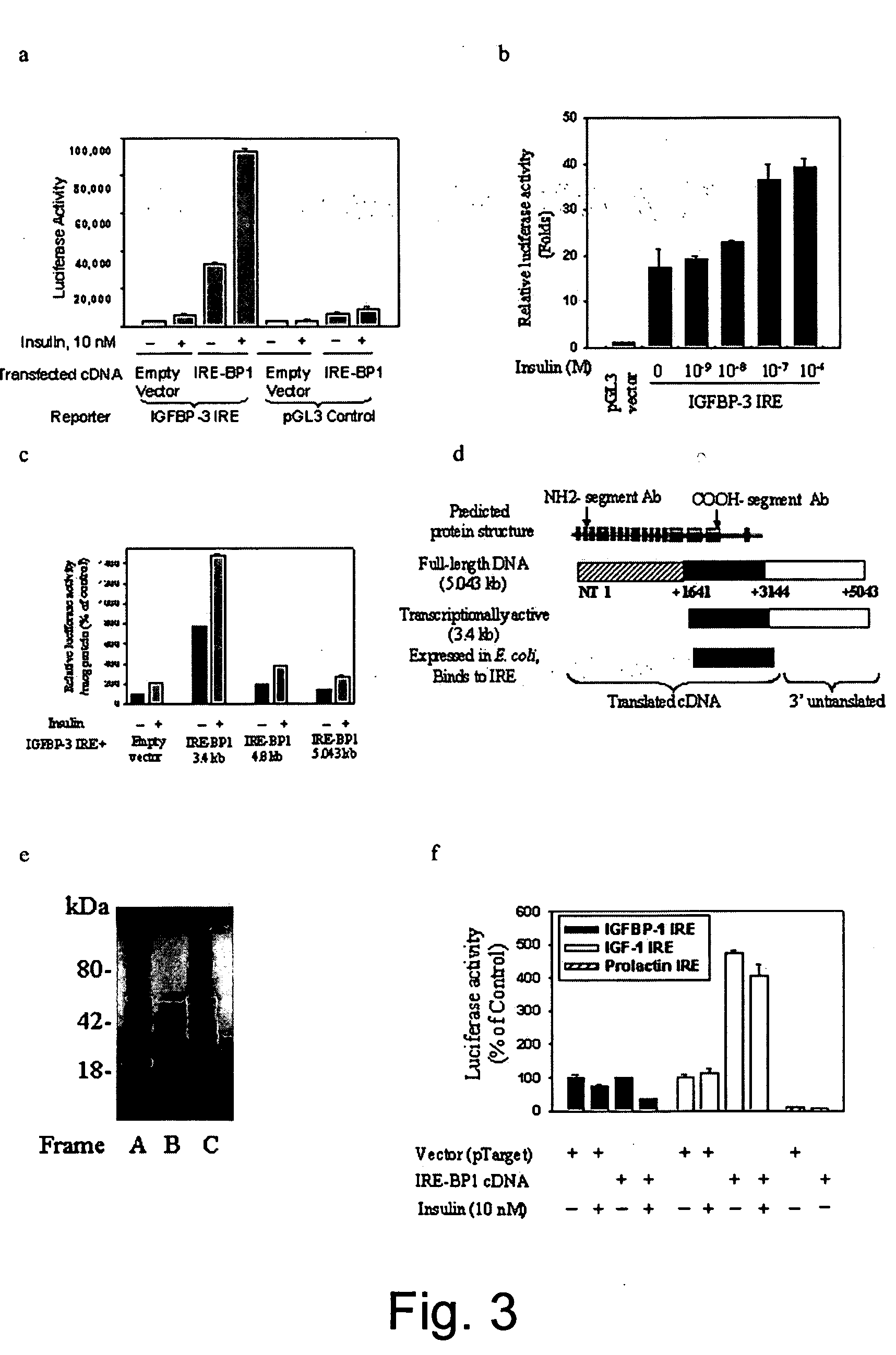Transcript factor and an Akt substrate related to transcriptional action of insulin and applications of same
a transcription factor and substrate technology, applied in the field of transcription factors, can solve the problems of reducing the glucose production after fasting, the molecular mechanism by which insulin transduces its effect on hepatic glucose production is not fully understood, and the high incidence of diabetes is a significant economic burden, so as to reduce the expression of gluconeogenic genes in the hepatic, and reduce the incidence of diabetes. the effect of fasting and post-prandial glucos
- Summary
- Abstract
- Description
- Claims
- Application Information
AI Technical Summary
Benefits of technology
Problems solved by technology
Method used
Image
Examples
example 1
Insulin-Response Element Binding Protein 1: A Novel Akt Substrate Involved in Transcriptional Action of Insulin
Experimental Procedures
[0058] Yeast One-hybrid cDNA Library Screening: Using the yeast one-hybrid system to screen a rat liver cDNA library (Clontech Inc., Palo Alto, Calif.), three tandem repeats of the IGFBP-3 IRE (−1150 to −1117 bp) was inserted upstream of a His3 reporter gene under the control of GAL4-responsive promoter, and the resulting plasmid was transformed into YM4271 yeast. Yeast containing the target element was co-transformed with an activation domain (AD) library that contains fusions between target-independent AD (GAL4 AD) and cDNA from normal rat liver. Colonies were selected on His− / Leu− plates with 15 mM 3-amino-1,2,4-triazole, and 79 yeast clones were picked. After DNA sequencing and confirmation of the ability of the cDNAs to transactivate a GAL4 promoter linked to a LacZ reporter gene, the cDNA was subcloned into a prokaryotic expression vector for...
example 2
Sensitin Decreased Hyperglycemia in Diabetes
Materials and Methods
[0089] Immunoprecipitation and western blotting: Total cell lysates from COS7, HepG2 and 3T3-L1 adipocytes were incubated with rabbit IgG and protein G-agarose at 4° C. for 30 mins. Then centrifuged. The pre-cleared lysates were transferred to a fresh microcentrifuge tube, incubated with 10 μg of agarose conjugated Erk antibody (Santa Cruz Biotechnology, Santa Cruz, Calif.) or with agarose conjugated anti-phospho Ser / Thr-POro monoclonal IgG (Upstate Biotechnology Inc., Lake Placid, N.Y.) overnight at 4° C., then centrifuged. The agarose pellet was washed with RIPA buffer 4 times, then subjected to western blotting. The blotted protein was probed with anti-sensitin antibodies as indicated.
[0090] Production of rabbit polyclonal antibody: To develop the N-segment antibody, the peptide fragment between amino acids 233-247 was used, with the following sequence: Acetylated Cys-Arg-As-Gly-Gly-Thr-Tyr-Lys-Glu-Thr-Gly-Asp-G...
PUM
| Property | Measurement | Unit |
|---|---|---|
| pH | aaaaa | aaaaa |
| pH | aaaaa | aaaaa |
| pH | aaaaa | aaaaa |
Abstract
Description
Claims
Application Information
 Login to View More
Login to View More - R&D
- Intellectual Property
- Life Sciences
- Materials
- Tech Scout
- Unparalleled Data Quality
- Higher Quality Content
- 60% Fewer Hallucinations
Browse by: Latest US Patents, China's latest patents, Technical Efficacy Thesaurus, Application Domain, Technology Topic, Popular Technical Reports.
© 2025 PatSnap. All rights reserved.Legal|Privacy policy|Modern Slavery Act Transparency Statement|Sitemap|About US| Contact US: help@patsnap.com



